Recognize when something is wrong with your dog
By Michele Welton, Dog Trainer, Breed Selection Consultant, Author of 15 Dog Books
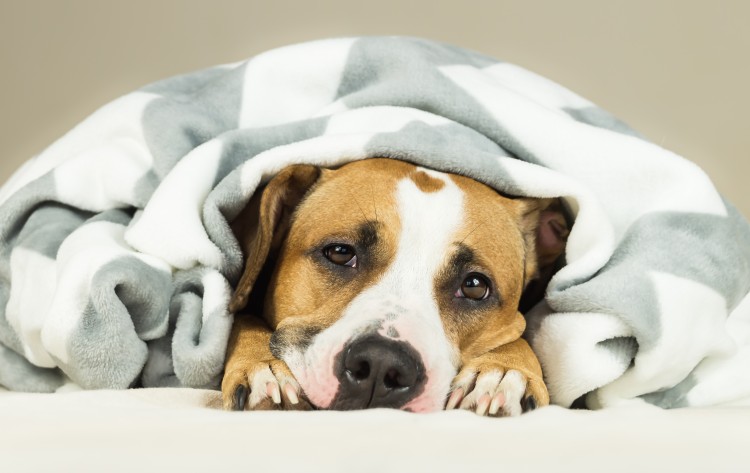
Even when you've followed the guidelines in my free online health care program and done your best to prevent things from going wrong....
....things still might go wrong. That's just the nature of living creatures.
At that point, the quicker you notice something wrong with your dog, the quicker and easier the problem can be resolved.
That means you should observe and examine your dog on a regular basis, looking at each part of his body and noting whether it looks normal or abnormal.
It is vitally important that YOU keep tabs on your dog's health. The vet can't do it. He's way the heck over there in the animal hospital. You're the one living with your dog, looking at him, feeding him, grooming him, petting him, taking him out to potty and play.
Those interactions are your opportunities to notice things. Get in the habit of turning on your Health Radar whenever you interact with your dog.
- Petting him gives you a quick feel of his skin and coat.
- Grooming him gives you a quick look at his eyes, ears, nose mouth, feet, toenails, and private parts.
- Taking him for a walk or playing with him gives you a quick look at how his legs and joints are functioning.
- Taking him out to potty or cleaning his yard gives you a quick look at his stool and urine.
These quick little observations can pick up the very beginnings of health problems when treatment will be most effective.
So this article, the final chapter of my free online health program, is about knowing what to look for when you look at, or interact with, your dog. Remember, you're the only one who can do this, so he's depending on you!
This article will walk you through a quick list of things to look for. A quick list. Entire books have been written on this topic, so I can't cover it comprehensively in one article! But I can give you the key highlights.
Nose
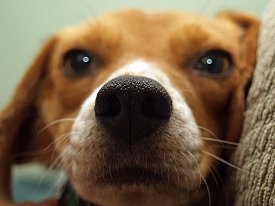
May be moist or dry, cool or warm. It's a myth that a dog's nose must be moist and cool to be healthy.
Most canine noses are black. However, chocolate-brown dogs (like chocolate Labs) have a brown nose. Blue/gray/silvery dogs (like Weimaraners) have a blue/gray nose. Merle-colored dogs (such as blue merle Australian Shepherds) may have a butterfly nose – black with pink patches.
Nose color doesn't affect health... except for a solid pinkish or flesh-colored nose (one without any pigment). Complete lack of pigment makes the nose more susceptible to sunburn and possibly skin cancer.
Interestingly, some dogs (especially retrievers, collie-type breeds, and northern "spitz-type" breeds) may have a normal dark nose in the summer... but then it fades to pinkish in the winter! This harmless phenomenon is called snow nose. The cause is not fully understood, but might be the breakdown of a pigment enzyme that doesn't work as well in cold weather. This same enzyme works less well with age, so the nose may fade more and more with increasing age.
Abnormal: Crusty or scabby ulcerations on the nose. Hairless patches around the nose. Chronic discharge, especially combined with persistent sneezing and watery or crusty eyes. Thick yellowish-green discharge. Chronic nosebleeds.
Dogs are inquisitive sniffers. Since their nose is often the first part of their body to encounter an object, it's prone to getting scratched, clawed, bruised, burned, or stung. Soothe an abraded nose (or a dry nose with cracks) with calendula ointment or aloe vera gel. With a cat scratch, add an antibacterial spray, as cat claws contain a LOT of bacteria.
Breathing
Obviously a dog shouldn't be coughing, wheezing, snorting, snuffling, gasping, or choking.
Unfortunately, if you have a short-faced dog such as a Pug or Bulldog, those sounds are par for the course, due to all the anatomical deformities. You should still speak to your vet about it; there are some medications and surgeries that might help.
If you have a small dog, it's normal for them to experience periodic episodes of snorting, wheezing, or "honking", especially during or immediately after eating, drinking, or excitement. This is a harmless phenomenon called reverse sneezing.
Otherwise, chronic coughing suggests heart disease, heartworm, fungal infections, cancer, respiratory infections such as kennel cough, or exposure to irritating chemicals or fumes such as aerosol sprays or cigarette smoke.
Lips and chin
Abnormal: Lips should not have raw patches or cracks. These are especially common in dogs with loose lips or extensive facial folds. Soothe with aloe vera gel.
Abnormal: Pimples on the chin could suggest a mild infection called folliculitis, which is sometimes referred to as "canine acne".
Abnormal: On bearded dogs, reddish-brown hair around the mouth may simply come from saliva leaching onto the hair. Trim the beard short, or dry it frequently with a towel.
Food can also stain the beard, as can minerals or heavy metals in your tap water – if possible, switch to filtered water.
Rolling in soil with a high iron content can stain the beard.
Finally, if your dog eats from a plastic bowl, he may be experiencing an allergic reaction leading to bacterial/fungal/yeast infections that turn the hair reddish-brown.
Mouth
Abnormal: Any growth or swelling on the tongue, roof, or floor of the mouth, especially combined with drooling or difficulty chewing.
Abnormal: Horrible breath. A dog's mouth does have some odor, but normally it isn't strong because the powerful acids in his saliva quickly kill odor-causing bacteria.
In fact, because of this, your dog has less bacteria in his mouth than YOU do. When he licks your face, he's more likely to pick up germs from YOU than you are from him.
But a seriously bad smell suggests a foreign body lodged somewhere in the tissues of his mouth, or an infection in his teeth, or kibble or canned food clinging to the teeth and rotting in the mouth. Eww.
What about those "breath-freshening rinses and sprays" on the pet shop shelves? Nope. Don't put those chemicals in your precious dog's body.
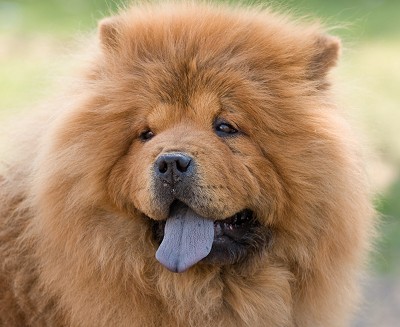
Chow Chow
Tongue
Usually pink, sometimes with black or brown pigment. Chinese Shar-Peis and Chow Chows (or mixes that include these breeds) usually have a purplish-bluish-blackish tongue.
Abnormal: Some small dogs have a protruding tongue that pokes through their front teeth or hangs out one side of their mouth. This may be an inherited structural defect or a mild neurological defect, but it seldom causes any problems. There isn't much you can do about it, in any case.
Gums
Gums should be pinkish, sometimes with splotches of black or brown pigment.
Abnormal: Whitish or yellowish gums suggest anemia (not enough red blood cells).
Gums should have no red lines at the base of any teeth.
Abnormal: A reddened gumline just above or below a tooth suggests gingivitis, an inflammation caused by tartar buildup at (and under) the gum line. Gingivitis requires professional tooth cleaning, which is unfortunate since it requires general anesthesia. But to remove tartar under the gum line, the vet must use an ultrasonic scaler, and your dog can't sit still for that.
Check capillary refill. Press your index finger against the gums. The gums should "blanch" (fade to a paler shade), then return to normal within 2 seconds after you stop pressing. This suggests that your dog's heart is pumping blood efficiently through his body.
Teeth
Teeth should be firmly rooted in the gum.
A tooth that's loose or wiggly can be uncomfortable when your dog tries to chew. The gum pocket around a loose tooth is also a haven for bacteria. If it's bad enough, a loose wiggly tooth should be removed by your vet.
Loose wiggly teeth are a very common problem in toy breeds, whose miniaturized gums don't provide enough support for teeth roots, and in short-faced breeds, whose compressed mouth cavity doesn't provide enough support for teeth roots.
Teeth should point straight up and down.
A crooked tooth may or may not be a problem, depending upon whether it's interfering with another tooth, or worse, poking into the soft tissues of the mouth when your dog chews. As with loose teeth, crooked teeth are a common problem in toy dogs and short-faced dogs.
Teeth should not be jammed together.
Two teeth stacked close together might mean that an adult tooth grew in beside a baby tooth without pushing the baby tooth out. This is called a retained tooth.
A retained tooth can be a problem because there's "not enough room at the inn" and the surrounding teeth may be forced to come in crooked, perhaps even growing towards the tongue or the roof of the mouth. Try chewing with a mouth like that!
Also, two teeth stacked close together provides an ideal hiding place for bacteria. So if a baby tooth hasn't fallen out by 12 months old, especially if it's influencing other teeth to grow badly, it should be removed.
As with loose teeth and crooked teeth, retained teeth are most common in toy dogs and short-faced dogs.
Teeth should be clean and white. Watch out for:
- an off-white, sticky film – that's plaque, which is made up of bacteria and saliva.
 a yellow-brown, hard calculus – that's tartar, which is hardened plaque.
a yellow-brown, hard calculus – that's tartar, which is hardened plaque.- a reddened gumline at the base of a tooth – that's gingivitis, an inflammation caused by tartar buildup under the gumline.
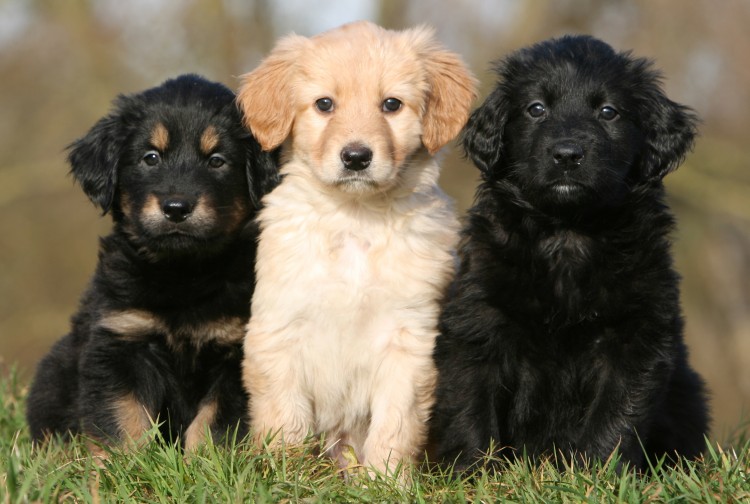
Hovawart puppies, rare breed, challenging to raise and train
Bite
Your dog's BITE should be a healthy one.
Wait... his BITE? What does that mean?
Bite means the way in which the dog's upper teeth and lower teeth fit together.
A scissors bite is the only healthy bite for a dog. In a scissors bite, the upper front teeth overlap the lower front teeth so snugly that the inside surface of the upper teeth touches (or nearly touches) the outside surface of the lower teeth.
This slightly-offset position keeps the teeth from grinding on top of each other when your dog closes his mouth or chews.
Less desirable bites
In a level/even bite, the upper and lower front teeth meet edge-to-edge and grind together.
As the dog ages, the grinding teeth may be worn down to the gum line. Unfortunately, many breeds are "allowed" by their Breed Standard to have a level or even bite. But "allowed" doesn't mean "healthy".
In an overshot bite, the upper jaw is considerably longer than the lower jaw, so that the upper teeth protrude over the lower teeth with a good-sized gap between them.
In people, we call this an overbite or sometimes "buck teeth". If the degree of overshot-ness is mild, this is okay. But if it's extreme, the teeth in the lower jaw can actually dig into the soft tissue in the roof of the mouth when the dog chews.
Finally, in an undershot bite, the upper jaw is shorter than the lower jaw, so that the lower teeth protrude in front of the upper teeth.
This is a very poor bite because the upper teeth can dig down into the dog's tongue or lower gums when he chews. Also, when the lower jaw juts out, the teeth often slant forward, making the bite even weaker and the teeth more likely to become loose and wiggly. As with a level/even bite, some breeds are "allowed" (or even required!) by their Breed Standard to have an undershot bite. Doesn't matter. It's unhealthy.
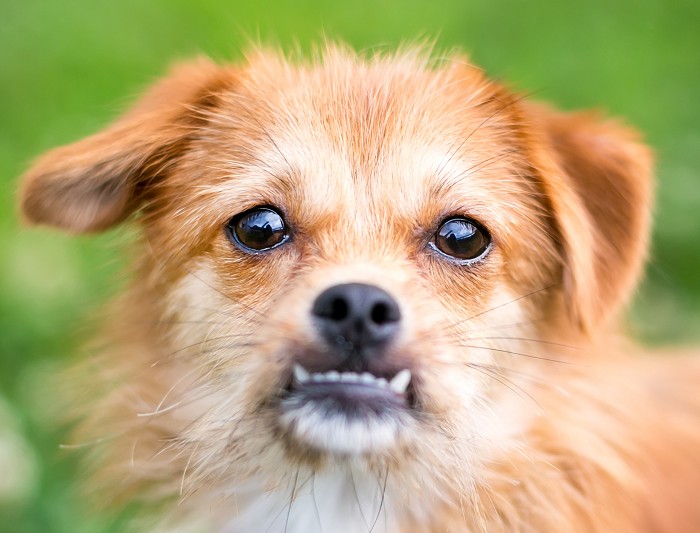
In a young puppy, the bite he has now may not turn out to be his adult bite. A level/even, slightly overshot, or slightly undershot bite at 8 or 10 weeks old may still correct itself into a healthy scissors bite with maturity. However, a severely overshot or undershot bite will not correct itself.
If your dog has a bad bite, make sure you don't breed him, as bad bites can be hereditary. Also monitor his mouth throughout his life to make sure any teeth out of alignment are not interfering with other teeth or with the soft tissue of his mouth, or with his ability to close his mouth or chew his food. If this occurs, dental surgery may be required.
Eyes
When examining your dog's eyes, remember that he has TWO of them. This comes in handy, because most eye disorders don't happen in both eyes at the same time. So comparing one eye to the other helps abnormalities stand out.
Normal eyes are the same size.
If one eyeball is enlarged or bulging, especially if it's also an odd color (whitish, bluish, reddened), and especially if it's causing discomfort (your dog is rubbing at it), this suggests a serious disease called glaucoma.
Dim the lights and shine a narrow-beam flashlight into the eye. A healthy pupil (the black circle in the center of the eye) should contract (get smaller) when the light is on it, and dilate (get larger) when the light is removed. In an eye with glaucoma, the pupil is often fixed in the dilated (larger) position.
A normal eye has a colored area (iris) surrounding the black pupil. The iris is usually brown (the most common eye color in dogs) but may be hazel, yellowish, or blue. Both eyes don't have to be the same color. A white area (sclera) surrounds the iris.
Abnormal: A cloudy/whitish spot in the eye could be a cataract. However, if your dog is over age 6, both eyes may have a blue-grey cloudiness as part of the normal aging process. Oh, it may obscure his vision a bit, but it's essentially benign, definitely not the same as the white opacity of a cataract.
Abnormal: A white sclera heavily streaked with blood vessels (bloodshot eye) suggests inflammation/infection. But don't panic – many healthy dogs always seem to have a few tiny blood vessels in one or both eyes.
Abnormal: A yellow or orange tinge to the white sclera suggests liver problems. A brown spot, brown pigment strands, or yellowish-greenish mucus, could be an eye disease.
Abnormal: Hair loss around the eyes suggests demodectic mange or ringworm.
Abnormal (but not serious): Moist, brownish stains under the eyes are tear stains. These are common on toy dogs, especially those with long or curly facial hair. The hairs act as a "wick" and direct salty tears down onto the face. To prevent the moist hairs from fusing together, regularly scrape off any gunk that forms in the corners of the eyes.
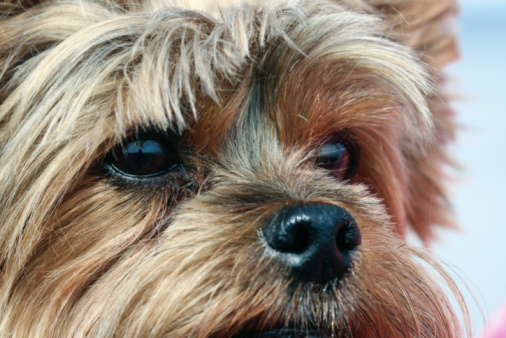
Eyelids should fit snugly around the eyeball. Remember that there is an upper eyelid and a lower eyelid.
Abnormal: Eyelids should not roll inward (called entropion) which can irritate the eyeball.
Abnormal: Eyelids should not roll outward either (called ectropion). This mostly occurs in the lower eyelids, causing a sagging/drooping that exposes the delicate conjunctival tissues and causes them to dry out, potentially leading to corneal damage.
Due to unwise breeding practices for the dog show ring, this congenital condition occurs most often in spaniels, Basset Hounds, Bloodhound, Saint Bernards, Newfoundlands, Bernese Mtn Dogs, mastiff breeds, and bulldogs.
Surprise... dogs also have a THIRD eyelid!
Look at the inner corners of your dog's eyes, beside the bridge of his nose. In the corner of the eye, can you see a small piece of dark "tissue"? If you can see it at all, you should just BARELY be able to see it, because in a healthy dog it's supposed to be pretty much hidden. It's actually a piece of cartilage with a tear gland in it. Officially it's called the nictitating membrane but more commonly we call it the third eyelid.
This third eyelid acts as sort of a windshield wiper when your dog blinks. It slides up quickly across his eye, sweeping away any debris and moistening the eye with tears from its tear gland. Then just as quickly, it slides back down into its corner again and hides. Pretty cool!
If the third eyelid comes out of its hiding place and comes up to partially cover the eyeball, this suggests some type of infection such as conjunctivitis.
If the third eyelid becomes inflamed (bright red) and bulges out, this suggests a condition called cherry eye.
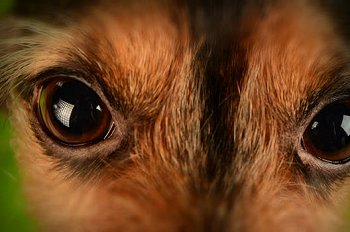
Healthy eyes!
Eyelashes should curl outward, away from the eyeball.
Abnormal: Eyelashes that roll inward can scratch the eyeball, causing watery discharge, pain (the dog paws at his face), squinting, and potentially leading to infection.
Finally, obviously, your dog should be able to SEE!
In some serious eye disorders, there are no physical symptoms of the eye itself – no redness or squinting or discharge or cloudiness. Instead, very quietly and unobtrusively, one or both eyes may simply lose the ability to SEE.
Abnormal: Signs of vision impairment include reluctance to go outside at night, reluctance to enter or move around in a dark room, or reluctance to use stairs. These symptoms suggest vision impairment and you should visit the vet.
Ears
Should be pinkish on the inside, sometimes with black or brown pigment.
Abnormal: any combination of these symptoms:
- Brownish waxy discharge
- Black or reddish-black specks (like coffee grounds)
- Shaking the head or holding it tilted to one side
- Urgent scratching of the ears
- Pushing the ear against your hand (begging you to rub it), or conversely, tenderness and discomfort when you try to rub it
Those symptoms suggest an ear infection – the most common ear problem in dogs. Ear mites are also a possibility.
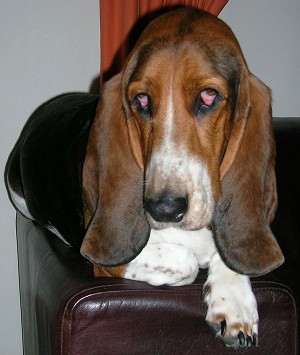
These ears are more vulnerable to ear problems. Also look at those eyes – the lower eyelids droop instead of fitting properly to the eyeball, and the third eyelid is inflamed. Bassets, unfortunately, are full of deformities, which means increased health problems.
Abnormal: Inflammation (a red flush inside the ears) could suggest allergies Inflammation plus pain suggests a foreign body such as a sharp or sticky weed (like a foxtail) that has worked its way into the ear flap or down into the ear canal.
Long ears (Basset Hound, poodles, spaniels, setters) are more susceptible to ear problems because their long narrow ear canals trap wax, providing a sticky medium in which fungi can grow and parasites can feed. Dogs with profuse hair inside their ears are also more susceptible because the hair acts as a magnet for moisture and crud.
Head and neck
Abnormal: Loose facial skin and facial folds are prone to infection because the folds trap moisture and dirt, providing a sticky medium for bacteria to grow. Keep these folds meticulously clean and dry.
Run your hands under your dog's neck. Just behind his jawbone, at the junction of his jaw and throat, are his lymph nodes. They should be small and soft, so much so that often you can't even feel them.
Abnormal: A swollen lymph node (feels like a hard pea under the skin) suggests an infection in the ears, teeth, or sinuses; or allergies, or a tick-borne disease... or the worst diagnosis: cancer (lymphoma).
Chest
As you run your hands down your dog's chest and between his front legs, continue feeling for lumps or growths.
Abnormal: The chest is a common location for a non-tumorous growth called a fatty lipoma. Usually these are harmless and only removed if they grow too large.
Under your dog's armpits are more lymph glands, so feel around that area for anything that feels swollen or hard.
Check your dog's heart rate (or pulse)
- Place your first two fingers (or your first four fingers, if your dog is large) on the LEFT side of his ribcage, just behind his left elbow. Slide your fingers around until you can feel his heart beating.
- Look at your watch. When the second hand hits 12, start counting the number of heartbeats you feel beneath your fingers. When the second hand reaches 15 seconds, stop counting.
Adult dogs under 30 pounds (and puppies of any size) typically have a heart rate of 25-40 beats in 15 seconds. Adult dogs over 30 pounds typically have a heart rate of 15-30 beats. Generally speaking, the larger the dog, the slower the heart rate.
If you can't seem to find your dog's heartbeat, try his pulse. The easiest one to feel is the femoral artery, on the INSIDE of your dog's thigh, up high in his groin area. Feel around with your first two fingers until you find the pulse, then count it the same way you counted his heartbeat. His pulse rate should be about the same as his heartbeat rate.
.Front legs
Run your hands down each front leg, creating a little pressure by squeezing your fingers gently around the bone shaft.
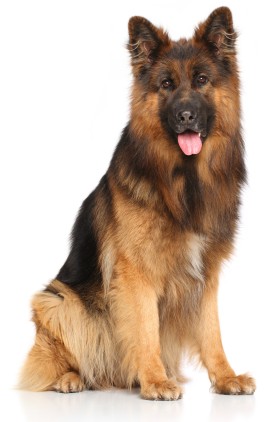
German Shepherd (longhaired)
Abnormal: In a 5-18 month old dog, especially of a largish fast-growing breed such as a German Shepherd or Rottweiler, tenderness of the front legs, combined with occasional limping, suggest a condition called panosteitis. An X-ray will confirm it. Usually it goes away with maturity, but meds to reduce pain and inflammation will make your youngster much more comfortable.
Abnormal: In an adult dog, tenderness plus limping (and perhaps swelling) could mean bone cancer. (osteosarcoma). Again this is most common in medium, large, and giant breeds.
Abnormal: On the front legs of a puppy or adolescent, look for small hairless patches that could suggest demodectic mange, especially with similar patches on the face.
The elbows are a major pressure point because they're covered with thin skin that comes in contact with the hard ground whenever your dog lies down. In large breeds, adult dogs often develop a thickened callous on their elbows, which is the body's way of helping to protect the joint. Sometimes you'll see and feel a soft fluid-filled lump under the skin around the elbow – this is simply the precursor to a future callous.
Front paws
Examine each toe, and BETWEEN each toe. Examine the footpads.
Abnormal: A growth or swelling between two toes suggests an infection, a tumor, or a foreign body (such as a foxtail) lodged in the skin.
Abnormal: Matted hair between the toes pulls on the skin and hurts when your dog tries to walk. Trim excessive hair around and between the toes and footpads, before it mats or collects prickly burrs or ice balls.
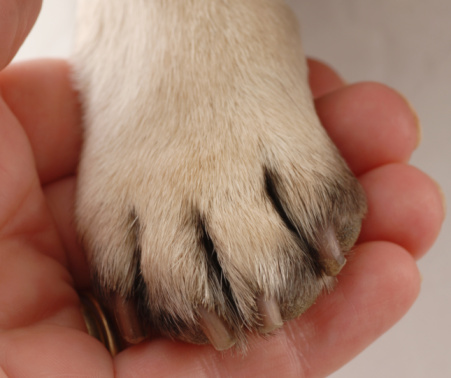
Properly trimmed toenails
Examine the toenails.
Your dog's nails should not be touching the ground when he walks. Imagine yourself trying to walk with your toenails pressing against the ground. You would need to rock back on your heels to take the pressure off. The same thing happens with your dog, and this unnatural shifting of weight can cause splayed feet and sore foot pads.
- If you can HEAR your dog's nails clicking when he walks on a hard surface, his nails are too long.
- If the tip of your dog's toenails extend well beyond the quick, his nails are too long.
 The quick is the big central blood vessel in each nail. Usually the quick stops just before the nail starts to curl downward. In light-colored nails, you can see the reddish/pinkish blotch of the quick. In dark nails, you have to guess.
The quick is the big central blood vessel in each nail. Usually the quick stops just before the nail starts to curl downward. In light-colored nails, you can see the reddish/pinkish blotch of the quick. In dark nails, you have to guess.
Don't forget the dewclaws.
Many dogs also have a fifth nail (called a dewclaw) on the inside of their front leg. Make sure that gets trimmed too, else it will grow around in an arc or circle, and puncture the dog's leg!
Read my step by step guide to cutting toenails.
Examine the hair on his front paws.
Abnormal: Reddish-brown stains on the front feet are caused by saliva, which gets onto the paws from chronic licking and chewing. Allergies, especially food allergies, are a major cause of paw-licking. Or there might be a foreign body lodged in the foot (such as a splinter or foxtail).
Abnormal: Look for a skin lesion near the wrist joint, where the skin is either raw and weeping, or hardened into a thick nodule. This could be a growth called a lick granuloma.
Hind legs and paws
Repeat your exam with the hind legs and feet, feeling for growths, tenderness, and matted hair. Check the length of the rear toenails; fortunately, it's very rare for a dog to have dewclaws on the rear legs, so that's one less nail to worry about!
There are three joints on your dog's hind legs: hocks (ankles), patellas (knees), and hips. All of these joints are susceptible to degenerative orthopedic diseases (dysplasia, osteochondritis, luxating patella, Legg-Calve-Perthes disease, and arthritis).
Most joint diseases are best observed by watching how your dog MOVES (we'll do this shortly), but some dogs will flinch or pull away when you simply manipulate or gently flex an affected joint.
Reflex Test: In middle-aged and senior dogs, lift one hind foot just off the floor and replace it so the TOP of the paw is resting on the floor. Let go of the paw. A dog with normal reflexes will quickly flip his paw back into its normal position. A dog who does this slowly (or not at all) could have a disk or spinal column disease impeding the nerves that control his reflexes.
Tail and anal area
Abnormal: Dampness, hair loss, or raw weepy skin at the base of the tail. These occur when a dog chews at his itchy skin, usually from fleas or allergies.
Abnormal: Around and near the anus, look for any lumps, red or ulcerated skin, or dried (or wet)fecal matter stuck to his hair. For sanitary reasons, try to keep this area clipped short.
Abnormal: You shouldn't expect this area to smell like a fragrant rose(!) but the odor shouldn't be dreadful either. If your dog has also been "scooting" his behind across the grass (or your carpet!), his anal glands could be full and need to be "expressed" (palpated and squeezed) by your dog's vet or groomer.
Dogs also scoot when they have an itchy bum, which could be caused by stuck fecal matter, fleas, or worms.
Abnormal: Due to unwise breeding practices, a few breeds (English Bulldog, French Bulldog, Boston Terrier, Pug) may have an oddly bent/twisted "corkscrew" tail. It's bent like that because the tail vertebrae are deformed into a shape called hemivertebrae. Now, as long as those deformed vertebrae are confined to the tail, they don't affect health... but if they're present in the tail they can also occur in the spine and then the result can be pain or paralysis.
Those twisted tails have loose skin that can lead to skin fold dermatitis (infection), as the dark, moist skin folds become populated by bacteria. The same is true of the loose facial folds of these same breeds – you must keep all of their skin folds thoroughly clean and dry.
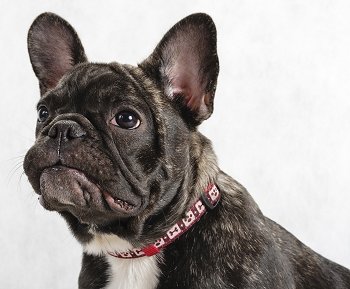
French Bulldogs have deformed heads with loose skin that forms unhealthy folds. Same with their tails, unfortunately.
Ladies Only (girl dogs)
Vulva
Keep long hairs around the vulva clipped short so they don't "wick" urine into the sensitive skin folds, where the moist dirty environment invites bacteria.
Abnormal: Red irritated skin in the folds of the vulva, especially combined with frequent licking. Dogs often lick at an inflamed vulva immediately after urinating, because urine burns!
Is there any discharge from the vulva?
Spayed females should have no discharge.
If your female is NOT spayed...
...a discharge could simply mean she's in heat. Her estrus cycles (also known as her "seasons" or "heat periods") begin at about 7-14 months old, and occur every 5-8 months (a very few females cycle only once a year).
Each estrus cycle lasts about 3 weeks. At first the discharge is thin and colorless, then bloody, then creamy or straw-colored around ovulation (day 10-12) when she is most fertile. Her vulva swells during this time, as well.
Warning: In an unspayed female, a discharge occuring 4-6 weeks AFTER a heat period could be bad news – pyometra, a serious infection where the uturus fills with toxic pus. This requires an immediate vet visit and an emergency spay.
A persistent heat period that lasts a lot longer than 3 weeks could suggest ovarian cysts. Ovarian cysts are diagnosed by ultrasound and treated by spaying.
Or, if your female STOPS having seasons, ovarian cysts could again be the culprit. (Did you know that dogs don't experience menopause? In older females, seasons may become shorter than 3 weeks, and more time may go by between seasons. But they shouldn't stop entirely.)
Breasts
Roll your dog onto her side or back, and palpate her mammary glands (breasts), paying special attention to the two rear breasts (closest to her tail).
Abnormal: A lump suggests a tumor, especially in older females who are not spayed or who experienced several heat periods before being spayed. This is because multiple heat periods produces a buildup of estrogen that contributes to tumor formation.
Abnormal: A discharge of milk 4-9 weeks after a heat period has ended, especially combined with enlarged breasts, abdominal distension, rooting into blankets (to make a den), or "mothering" stuffed toys, suggests false pregnancy (assuming you're sure she isn't actually pregnant).
False pregnancy is, in fact, normal in wild dogs. Within a pack, only the top female is allowed to get pregnant, while some of the other females had false pregnancies so they could help feed the pups!
False pregnancy needs no treatment and resolves itself in a few weeks – about the time the dog would have given birth had she truly been pregnant.
Unfortunately, false pregnancies can throw a dog's hormonal system into disarray, and once she has one, she will probably have another. To avoid this, she should be spayed a couple of weeks AFTER the false pregnancy has ended. This gives her internal organs and hormones a chance to recover before the surgery.
You can minimize the risk of breast tumors and breast cancer – and prevent false pregnancies entirely – simply by spaying your female when she is young and strong (just AFTER her first heat period). Don't wait until she requires an emergency spay when she is older, weaker, and perhaps already sick. But don't spay too early or you'll just be causing different problems.
Gentlemen Only (boy dogs)
Testicles/scrotum
If your male is neutered, make sure the healed-up scrotum area has no irritated skin or lumps.
If your male is NOT neutered...
Feel for TWO testicles in his scrotum. Did you know that a male puppy is born with both testicles up inside his abdomen? Between 2 and 12 weeks of age they're supposed to descend into his scrotum. It's okay if they come down, then go back up, then come down again, and so on, especially when he's cold or nervous or excited.
But if a dog reaches 8-10 months old and one (or both) testicles has never come down, that's a health issue called cryptorchidism (crip-TOR-ka-dism).
Unfortunately, one or both testicles retained inside the body is at high risk for developing cancer. So a dog with a retained testicle(s) should always be neutered.
A lump in either testicle, or one testicle larger than the other, suggests a tumor. It's fine for one testicle to hang slightly lower than the other, but they should be about the same size.
A warm swollen testicle(s), especially combined with excessive licking and discomfort, suggests testicular inflammation (orchitis), usually stemming from a prostate infection, a urinary infection, a fungal infection, a tick-borne infection, or an injury (such as a bite wound).
Penis
An occasional clear discharge is no cause for alarm.
Abnormal: A yellowish-green or bloody discharge, especially combined with excessive licking or swelling, could suggest an infection or tumor.
Abnormal: In an older dog, an intermittent yellow or bloody discharge, especially combined with intermittent bloody urine, or straining to poop, could suggest an enlarged prostate.
But don't panic! An enlarged prostate is common in non-neutered males and usually causes no other health problems. But if your older dog also doesn't feel good (abdominal discomfort, stiff gait, or lethargy), this could suggest a bacterial infection in the prostate gland. Finally, the prostate gland is susceptible to cancer, and unlike human prostate cancer, canine prostate cancer often spreads rapidly through the body.
Groin
Roll your dog onto his or her side or back.
Abnormal: In the groin, a lump or bulge under the skin suggests a hernia. An umbilical hernia would be up near the rib cage where the umbilical cord connected the puppy to its mother. An inguinal hernia would be on the inner thigh of the rear leg.
Abnormal: A lump or growth could also be a swollen lymph gland. Swollen lymph glands in the groin, especially if they're also swollen in the neck or armpit, could suggest an infection, allergies, tick-borne disease, or cancer (lymphoma).
We'll be looking carefully at your dog's skin and coat in a little bit, but since he is already lying on his side or back, this is the perfect opportunity to check the groin for FLEAS. You may actually see the little buggers scurrying across the sparsely coated skin in the groin, or you may see tiny black specks that look like flecks of pepper. That's flea "waste".... gross. Pick off a couple of specks, crush them, and dab at them with a wet paper towel – if they turn red, you're looking at blood, which fleas consumed from your dog, then excreted onto his hair.
Torso (from neck to hindquarters)
A normal body...
isn't in any discomfort or pain when you press on it.
Run your hands slowly over your dog's shoulders and back, along his sides, and under his stomach and chest. As you probably know by now, you're looking and feeling for things like ticks, growths, sores, or tumors.
You're also looking and feeling for signs of tenderness.
If your dog shows discomfort when you palpate his BACK, especially combined with difficulty walking or reluctance to run and jump, this could suggest intervertebral disk disease.
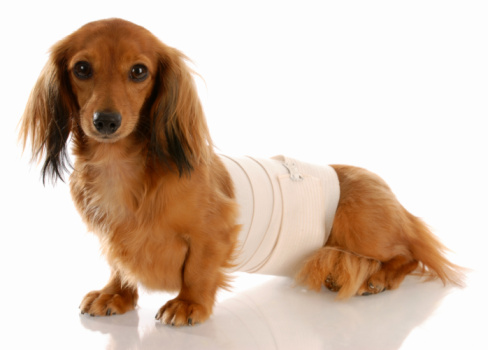
Your dog's weight and shape
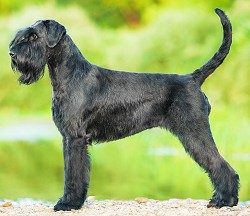 Crouch down to your dog's level and look at him from the side – his profile. His belly should be taut, held firmly up against his body. Of course this is easier to see on a shorthaired dog. With a longhaired dog, you'll need to feel with your hands.
Crouch down to your dog's level and look at him from the side – his profile. His belly should be taut, held firmly up against his body. Of course this is easier to see on a shorthaired dog. With a longhaired dog, you'll need to feel with your hands.
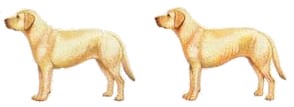
These dogs are in good condition
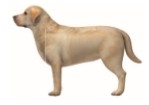
Overweight
Your dog's belly shouldn't sag down toward the same level as his chest and ribs. Older dogs tend to be saggier in the belly, but you want to minimize this. Extra weight is bad for aging organs and joints.
Stand close beside your dog and look down at his torso. You should see sort of an hourglass shape – wide-ish across his ribs, narrower across his waist (called the loin), and wide-ish again across his hindquarters. With longhaired dogs, you'll need to feel with your hands.

These dogs are in good condition
What you don't want is a sausage-ish shape that doesn't vary much in width.

Overweight
Put your hands on your dog's rib cage on each side of his body. You should be able to feel his ribs with your fingers without needing to push hard. But you shouldn't be able to see his ribs sticking out – unless your dog is a sighthound (such as a Greyhound) who DO have an extremely streamlined build with more prominent ribs.
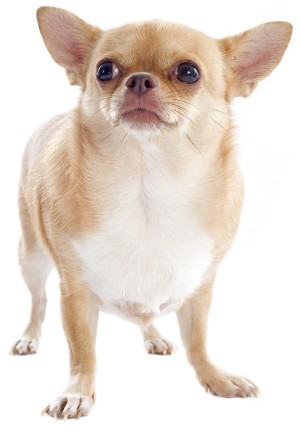
No two ways about it, this little dog is fat, which is terrible for both his short- and long-term health.
Unfortunately, many owners, when assessing their dog's weight, have the same blind spot they have for their own weight.
But you should try hard to be objective, because extra weight puts major stresses on your dog's heart, lungs, and joints.
How to help your dog lose weight
Stop feeding snacks, tidbits, cookies, and biscuits.
Stop feeding all kibble and canned food, especially those marketed as "weight loss" diets. The ingredients in most of those diets are atrocious, and the puny amount you're told to feed your dog keeps him perpetually hungry and unhappy.
Instead, feed real food, but....
- Eliminate all grains (rice, pasta, bread, etc.), legumes, fruits, milk and cheese, and high-calorie vegetables like potatoes, yams, sweet potatoes, peas, and carrots.
- Basically you want to feed only meat/fish (plus bone or calcium) and lots of low-calorie veggies such as summer squash, zucchini, celery, asparagus, and cauliflower.
- Increase exercise.
- If the above tips don't bring your dog's weight down, cut back the amount of food by about 10%.
Just as with people, obesity in dogs is almost always caused by too much food, too much of the WRONG food, and/or not enough exercise.
But in middle-aged and older dogs, obesity can also be caused by hypothyroidism especially when combined with loss of energy, flaky skin, a dry coat, or symmetrical hair loss where the hair is normal along your dog's backbone and over his shoulders, but thin along the sides of his body, on his thighs, and under his neck and stomach.
A normal canine body...
...is shaped roughly like a wolf or fox – medium height and weight, medium-length back, medium-length legs, medium-length nose.
Spitz-type breeds, shepherds, collies, retrievers, and many other breeds have a more-or-less normal body shape.
Other sizes and body shapes in dogs were specifically designed or perpetuated by man. The problem is, if you fool around too much with Mother Nature, you get increased health problems.
- Giant dogs have an abnormal build that results in more bone and joint diseases, a greater risk of heart disease and cancer, and a much shorter lifespan.
- Tiny dogs have an abnormal build that's prone to injury and broken bones, dental disease, and hypoglycemia (low blood sugar).
- Long-legged, slender sighthounds have an abnormal build that's prone to pulled muscles, leg fractures, and broken toes. Their thin skin can develop hygroma (pressure sores), and with so little fat on their bodies, they are tricky to medicate or anesthetize without overdosing.
- Short-legged, long-bodied dogs have an abnormal build called chondrodysplasia, which increases their risk of orthopedic diseases and crippling back problems.
- Short-faced dogs have an abnormal build called brachycephalic syndrome, which greatly increases their risk of respiratory problems, heatstroke, eye problems, gastrointestinal problems, and dental disease, as well as making them tricky to anesthetize.
- Heavily-jowled dogs have an abnormal build that causes drooling and slobbering, which leads to increased skin infections around their mouths.
- Heavily-wrinkled dogs have an abnormal build that leads to increased skin infections and eye problems.
Breeders (and owners) should remember the old saying: "It's not nice to fool Mother Nature."
Skin and coat
In going over your dog's body, you've spent a lot of time feeling for growths and lumps. It was time well-spent, because the skin and coat are THE major trouble areas in dogs, especially purebred dogs.
Along with growths and lumps, the most common skin and coat problems are itchiness, hair loss, raw irritated skin, and parasites. So let's look carefully at your dog's coat and skin for any signs of these problems.
ITCHY SKIN DISORDERS
- Persistent scratching often suggests allergies, especially if your dog also rubs his face against the carpet or furniture, or chews and licks at his feet or legs.
- Persistent scratching/chewing focused on the hindquarters, base of the tail, and groin suggests fleas.
- Intense scratching/chewing, combined with small red crusty papules on sparsely-coated skin (armpits, stomach, groin, elbows, edges of the ears), could suggest sarcoptic mange.
- A red rash that creeps along the surface of the skin (mostly on the head and neck) could suggest ringworm The skin is usually itchy, but not always.
- Greasy hair and skin that smells rancid, with yellowish/brownish flakes clumping to the roots of the hair, could suggest seborrhea.
- Lots of flaky white dandruff, combined with dryness of the skin and coat, could also suggest seborrhea.
HAIR LOSS DISORDERS
In middle-aged or elderly dogs...
- Symmetrical hair loss, where the hair is normal along the backbone and over the shoulders, but thin over the sides of the body, the thighs, and under the neck and stomach, could suggest hypothyroidism, especially when combined with flaky skin, dry coat, loss of energy, obesity, and coldness (seeking warm places to sleep).
- Symmetrical hair loss combined with a sagging pot belly and increased drinking/urination, could suggest Cushing's disease
In young dogs...
- Small hairless patches (NOT itchy) on the face or front legs could suggest demodectic mange.
In unneutered males...
- Hair loss combined with a lump in a testicle could suggest a sertoli cell tumor.
In longhaired or furry dogs who have been shaved close to the skin...
- Hair that doesn't grow back suggests a syndrome known as post-clipping alopecia (aka Alopecia X), where the hair follicles have been damaged by the clipping and may not grow back for months or years.
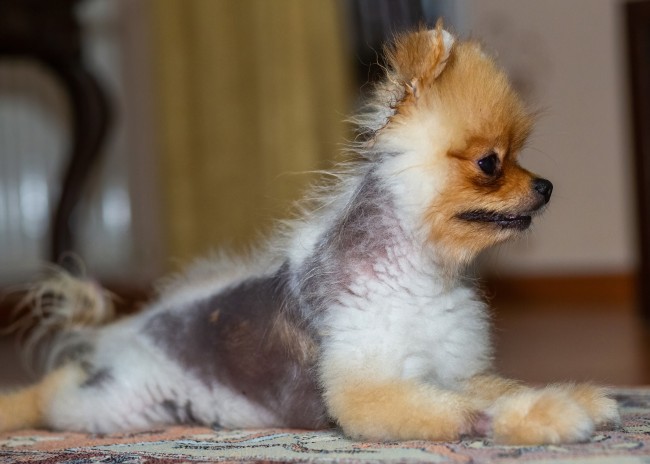
Pomeranian with alopecia
A serious skin disease called sebaceous adenitis might be the culprit...
- ...in Standard Poodles, Akitas, Lhasa Apsos, Old English Sheepdogs, Golden Retrievers, and a few other breeds, if the symptoms are extensive hair loss on the head and neck and along the back and spine. Also look for silvery scales sticking tightly to the remaining hair tufts.
- ...in Vizslas, Dobermans, and other shorthaired breeds, if the symptoms are limited hair loss that produces a patchy "moth-eaten" coat, especially on the head.
Follicular dysplasia might be the culprit...
- ...in spitz/northern breeds (Alaskan Malamute, Siberian Husky, Pomeranian, etc.), where the hair loss affects most of his body except for his head and legs, which remain normally-coated).
- in light blue/gray dogs where the hair loss is most noticeable along the midline of the back and along the dog's sides and thighs.
In the Good News department, there is a hair loss syndrome that's harmless:
- In Dachshunds, Chihuahuas, Italian Greyhounds, Whippets, Boston Terriers, and a few other smallish breeds, limited hair loss on the temples (the sides of the forehead), beneath the neck and stomach, and on the back of the thighs suggests a harmless condition called pattern baldness. In some individuals, this hair loss may occur only on the ears.
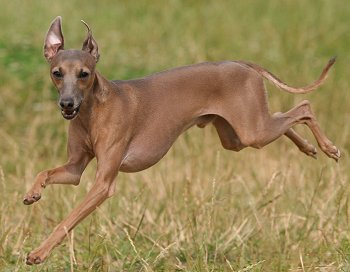
Happy, healthy Italian Greyhound
SKIN INFECTIONS
Any skin condition that causes your dog to scratch, even a little, can result in broken skin, which is an open invitation for bacteria or yeast to move in and colonize the broken skin, resulting in a secondary bacterial or yeast infection.
In fact, one of the most common skin problems in dogs is called acute moist dermatitis, commonly known as "hot spots". Symptoms include red weeping lesions that swell the skin and exude pus and serum. These are most commonly found on the hindquarters and base of the tail, where dogs scratch and chew frantically at flea bites.
Breeds with loose folds of skin, such as lip folds, facial folds, or body folds, are vulnerable to skin fold dermatitis.
SKIN PARASITES
We've already talked about ticks, which you can see with your eyes and feel with your fingers, as they crawl slowly through the hair or attach themselves to the skin with their mouthparts.
And we've already talked about fleas, which are easiest to spot on sparsely-coated skin such as the groin and stomach. You can also use an extra-fine-toothed flea comb to see if you catch any of the little buggers.
Lice are not found on clean healthy dogs, but if you've just rescued a really weak, dirty, neglected dog, you may see adult lice on the skin (they have flattened bodies and no wings). More likely, you may see their eggs (nits) attached to shafts of the dog's hair. A coat with lice is usually dry and scruffy, and often itchy. Some forms of lice suck blood, while others chew on the skin.
The kinds of lice found on dogs are NOT the same kind found on people, so don't worry about cross-contamination. Canine lice stay on a dog for its entire life cycle. The same treatments that prevent and kill fleas also prevent and kill lice, which are the easiest canine parasite to eliminate.
Foxtails are wild grassy weeds with sharply barbed seeds. So they aren't really parasites – but to dog owners in California and some other states west of the Mississippi, foxtails are dangerous scourges.
Foxtails contain a living bacterium that helps the seed burrow into the skin like a barbed fish hook, trailing a channel of pus. If this pus reaches the brain or heart or lungs, it can be fatal.

Foxtails grow during the spring rains and dry out in the summer. The dried seed at the top of the stalk hangs down like a fox's tail and sticks to your dog's fur if he brushes past it.
During the summer and fall in foxtail country, stay away from fields where the stuff is growing. Also check your dog's eyes, ears, nose, throat, paws, toes, and belly every day, just in case. You must catch these dangerous invaders quickly. Put booties on your dog if necessary.
If you find a foxtail before it has burrowed completely beneath the skin, you can soak it with mineral oil to stop its burrowing, then remove it with tweezers. But if you notice any swelling or an oozing break in the skin, it could be an already-burrowed-in foxtail and you should see the vet immediately so it can be removed (surgically, if necessary).
SHOULD THE COAT SMELL?
Well, yes and no. Your dog is not going to be as odorless as a stuffed toy. All living creatures with skin give off some odor from time to time – just like you do!
Some breeds do have distinctive odors that smell much more "doggy" than other breeds.
I personally find the strongest-smelling breeds to be retrievers (such as Goldens and Chesapeakes), scenthounds (such as Basset Hounds and Beagles), spaniels (such as Cockers and Springers), and dogs that are "gassy" (bulldog-type breeds, mastiff-type breeds, and short-faced breeds who gulp a lot of air).
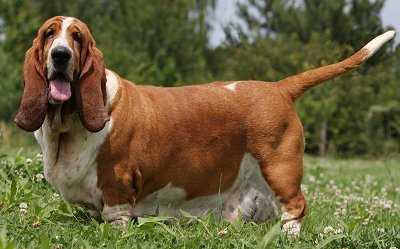
Abnormal odors can be caused by:
- anal gland impactions
- bacterial skin infections
- ear infections
- seborrhea
- bad breath, which typically results from feeding kibble or canned food, which clings to the teeth and rots in the mouth (leading to dental disease), and which doesn't digest well, causing foul-smelling belches and flatulence
Whenever your dog "smells bad", it's tempting to try to shampoo the odor away, but if it's a chronic problem, extra baths will simply dry out the skin, setting your dog up for even more skin problems.
SKIN HYDRATION
Before we leave your dog's skin and coat, let's check one last indicator of health: is his skin well-hydrated, i.e. does it have adequate moisture?
With your fingers, gently lift a small section of the loose skin above your dog's shoulder blades. This is called tenting the skin. When you release it, well-hydrated skin is springy so it falls quickly back into place, while de -hydrated skin retains its tented shape longer than it should. (The same test works for people, too! Tent the skin on your own forearm.)
Gait/movement
Some health issues aren't evident until your dog moves. Observe him regularly as he walks around your house, runs around your yard, climbs stairs, or jumps onto the sofa. Or have a friend walk him and trot him on-leash while you observe.
REAR END DISCOMFORT
Symptoms include:
- Limping or favoring a rear leg
- Moving stiffly
- Reluctance to walk too far
- Discomfort when trying to sit down, or when rising from a sitting or lying-down position
- Moving both rear legs at the same time (bunny hop)
- Sitting on one hip, with one rear leg extended stiffly
- Tucking one hind leg up into the groin
- Suddenly "skipping" or "hopping" (lifting one hind leg for a few steps) while walking or running
A dog who isn't moving "right" may have simply pulled or sprained something. Could even be as minor as a mat pulling on the skin in his groin, or a thorn stuck in the pad of his foot, or a torn toenail.
Other causes of rear-end discomfort include:
- hip dysplasia
- arthritis (middle-aged and older dogs)
- luxating patella
- cruciate ligament rupture
- intervertebral disk disease
- osteochondritis of the hock (ankle) joint
- cancer of the bone (especially combined with a lump or swelling or tenderness when gently squeezed)
- tick-borne infection (especially combined with a swollen painful joint)
- fungal infection
- Legg-Perthes disease (4-12 month small breeds)
- hypertrophic osteodystrophy (3-6 month large breeds)
- panosteitis (5-18 month large breeds)
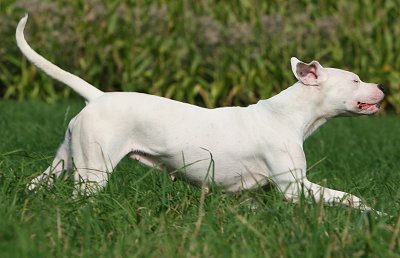
Dogo Argentino (aka Argentine Dogo), a powerful, vigorous, and challenging breed to raise and train
FRONT END DISCOMFORT
Symptoms include:
- Limping or favoring a front leg
- Reluctance to walk too far
- Moving stiffly (as though he needs to "warm up") after he has been lying down for awhile
- Reluctance to jump over or onto something (because it hurts to land on his front legs)
- A stilted, choppy gait
- Swinging his front legs in wide arcs
- Standing with his elbows tucked into his chest (or with his elbows bowed out)
A dog who isn't moving "right" may have simply pulled or sprained something. Could even be as minor as a mat pulling on the skin in his groin, or a thorn stuck in the pad of his foot, or a torn toenail.
Other causes of front-end discomfort include:
- elbow dysplasia
- arthritis (middle-aged and older dogs)
- cervical disk disease
- osteochondritis of the shoulder or elbow joint
- cancer of the bone (especially combined with a lump or swelling or tenderness when gently squeezed)
- tick-borne infection (especially combined with a swollen painful joint)
- fungal infection
- hypertrophic osteodystrophy (3-6 month large breeds)
- panosteitis (5-18 month large breeds)
Sometimes it's hard to tell exactly which leg is causing the problem. One clue to watch for is your dog standing with his weight shifted to one side of his body, which suggests that the other leg (the one he doesn't want to put any weight on) is the sore one.
Wobbliness, incoordination, tremors, paralysis
If your dog becomes wobbly or uncoordinated, loses sensation in his hindquarters, or experiences tremors of his head or body, this suggests a disorder of the brain or nervous system.
- Dogs with a pinched spinal cord from disc disease will drag their toes as they lose sensation in their hindquarters. This is most common in Dachshunds, French Bulldogs, Poodles, Pekingese, Lhasas, Cockers, and a few other breeds, but can occur in any breed.
- Large-breed dogs with Wobbler's syndrome (another form of pinched spinal cord) move as though they don't know where their feet are, scuffing them or tripping over them. They may also hold their head and neck in a downward position to relieve the pinching in their neck. It's most common in Great Danes (3-18 months old) and Dobermans (3-8 years old), but can occur in Pointers, Saint Bernards, Old English Sheepdogs, Borzois, and other large breeds.
- Middle-aged and elderly dogs with degenerative myelopathy (deterioration of the spinal cord) drag their rear toes when they walk and become wobbly in their hindquarters. To test for this: lift one hind foot just off the floor and replace it so the TOP of the paw is resting on the floor. Let go of the paw. A dog with normal reflexes will quickly flip his paw back into its normal position. A dog who does this slowly (or not at all) could have DM, which impedes the nerves that control his reflexes. It's most common in German Shepherds, Corgis, Siberian Huskies, Golden Retrievers, Collies, and Pugs, but can occur in other breeds.
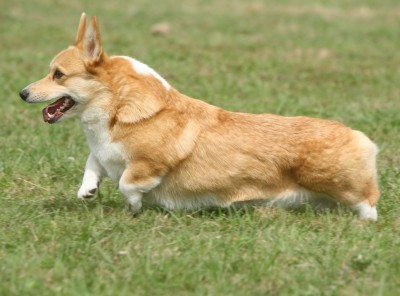
Pembroke Welsh Corgis are vulnerable to a serious neurological disease: degenerative myelopathy.
- Short-faced puppies with hemivertebrae (defective vertebrae pinching their spinal cord) become wobbly and drag their toes. Seen in French Bulldogs, English Bulldogs, Boston Terriers, and Pugs.
- Puppies with a liver shunt (a blood-vessel deformity in the liver) walk in aimless circles, lose their balance, stagger as though disoriented, tilt their head to one side, or push their head against a solid object and hold it there. Symptoms usually occur shortly after eating a meal, because the defective liver is unable to filter the toxins that accompany the digestion of food; so these toxins sweep through the bloodstream and into the brain, causing neurological symptoms. Many breeds can be born with a liver shunt, but most commonly affected are Yorkshire Terriers (by far); also Beagles, Irish Wolfhounds, Cairn Terriers, and Old English Sheepdogs.
- Toy breed puppies with hypoglycemia (low blood sugar) suddenly become weak and wobbly, either staggering about as though disoriented, or collapsing completely.
- Dogs with an inflammatory brain/spinal disease such as meningitis or encephalitis (usually Pugs, poodles, and terriers) develop a stiff neck and staggering gait. Alternatively, breeds such as Beagles, Bernese Mountain Dogs, and Scottish Deerhounds may stand with their head and neck stiffly extended, back hunched, reluctant to move.
- An autoimmune form of brain inflammation can occur in small, young-adult dogs such as Westies, Maltese, Cotons, and Poodles. This disease is called white shaker dog syndrome, but other colors can also be affected. Symptoms include an all-over tremor that becomes worse with excitement and exercise.
- Small breeds with domed heads (especially Cavalier King Charles Spaniels) may suffer from syringomyelia, a neurological disease where the brain stem doesn't fit in the skull. Affected dogs experience abnormal skin sensations that make them scratch at their shoulder (or at the air near their shoulder). Affected dogs may also be sensitive around their head, neck, and front legs, and the worst cases can suffer great pain, seizures, or difficulty walking.
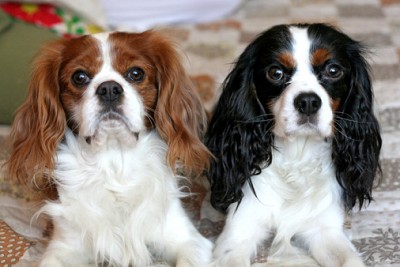
Cavalier King Charles Spaniels are vulnerable to inherited syringomyelia, heart disease, epilepsy, hip dysplasia, eye diseases, luxating patella, and itchy allergies. You should have a goodly amount of money socked away to deal with health problems in this lovely (but unlucky) breed.
- Dogs with a tick-borne disease (a serious infection carried by ticks) may have a wobbly gait, partial paralysis, or tilt their head to the side because they're off-balance.
- Toy breed puppies born with hydrocephalus (colloquially known as fluid on the brain) have an enlarged head and experience episodes of dullness and disorientation.
- Scottish Terriers with Scottie cramp (a neuromuscular disease in which signals from the brain get garbled on their way to the muscles) display a bizarre "spastic" gait when they're excited or vigorously active.
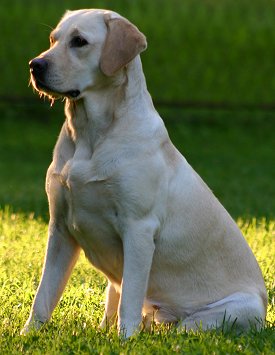 If your Labrador Retriever has inherited a particular gene mutation, you must keep an eye on him during vigorous exercise. He may suddenly begin swaying, then collapse, then require a rest before he can move again. This odd disease is called exercise-induced collapse. Other breeds may also show symptoms of this condition, but it doesn't appear to be caused by the same gene mutation.
If your Labrador Retriever has inherited a particular gene mutation, you must keep an eye on him during vigorous exercise. He may suddenly begin swaying, then collapse, then require a rest before he can move again. This odd disease is called exercise-induced collapse. Other breeds may also show symptoms of this condition, but it doesn't appear to be caused by the same gene mutation.- Dogs with myasthenia gravis have defective "neural receptors" in their muscles, so signals from their brain don't make it to their muscles. Too much exertion and they collapse and need to rest.
- Dogs with narcolepsy (another neural receptor disease) collapse so completely that they become totally paralyzed for a few seconds. These sudden episodes are triggered by some sort of excitement or stimulating experience that causes the dog to lose all muscular control and flop onto the ground.
- Puppies with cerebellar ataxia (a rare brain degeneration) drag their hind feet, trip over their front feet, or walk with spastic jerky movements or an unsteady drunken gait. They may tremble and lean against a wall for support, or plant their feet wide apart for balance.
- Dogs with a lysosomal storage disease (a rare brain/nervous system disease) suffer incoordination, loss of balance, tremors, and often vision problems. They may appear to forget things that they've learned, or display sudden anxieties or even aggression.
- Muscle weakness and shaky legs can also occur if a dog has a disease of his red blood cells in which not enough oxygenated blood reaches his muscles. This can cause episodes of extreme weakness, especially during or after exercise. Red blood cell diseases include autoimmune hemolytic anemia, PK deficiency, and PFK deficiency.
The most frightening "movement abnormality" is a seizure, which is a sudden, unexpected burst of electrical activity in the brain.
A dog experiencing a very mild seizure may simply stare rigidly into space, twitch his head, blink rapidly, snap at the air, or bite at his body.
In contrast, a full-blown seizure sends all of your dog's muscles into spasms and he falls onto his side, his whole body rigid, legs extended, feet paddling as though trying to run. He may drool or lose control of his bladder or bowels. He may lose consciousness. As I said... frightening.
Seizures look awful but fortunately they're not painful. Just place your hands gently on your dog's body to protect him from flinging himself about. Speak cheerfully to him. The seizure should end within 1-3 minutes. For longer seizures, your dog needs emergency veterinary intervention.
Monitor your dog's urine
Normally, dogs urinate every 4-5 hours during the day. Puppies, with their immature bladders, may urinate every 1-3 hours during the day.
Abnormal: Sudden urge to urinate where the dog rushes for his potty yard every hour or so, especially combined with straining to urinate yet producing very little. These symptoms can be caused by a UTI or bladder stones, or by drinking too much water due to a systemic disorder such as diabetes or Cushings disease, or by certain medications such as prednisone (steroids).
Urine in the bladder burns, so working owners who make their dog "hold it" for 8-10 hours every day are doing the poor dog a grave injustice.
Nighttime is different. At night, your dog's metabolism slows way down for sleeping, so he can last through the night without urinating. But during the day, he needs opportunities to release urine from his bladder.
Normal urine is "well-concentrated" (meaning a strong yellow color and ammonia odor) first thing in the morning when your dog hasn't had a chance to potty all night.
Abnormal: Orange- or blood-tinged urine.
Abnormal: "Leaking" urine occurs when your dog dribbles urine, seeming to have no control over it, and appearing oblivious or embarrassed.
In many dogs, especially youngsters, a sudden release of urine can be caused by excitability or submissiveness. It's not a housebreaking issue or a health issue.
In middle-aged spayed females, leaking urine can be caused by being spayed too early, before their reproductive hormones had enough time to build the strong muscles and tissues of the bladder. These ladies will need lifelong hormone administration.
Leaking urine or sudden wet spots in the house can also be caused by a urinary tract infection, by an orthopedic disease where it hurts the dog to arise and walk outside to potty, or by senility (canine cognitive decline).
Monitor your dog's stools
This examination is getting worse and worse, isn't it? But what goes in must come out! The question is: Does it come out normally?
Soft stools or diarrhea
Abnormal: Chronic soft, loose stools, or more than 3 stools per day. These are common complaints for dogs eating kibble or canned food, which has ingredients dogs can't readily digest, especially wheat, corn, or soy. The solution is to feed digestible, species-appropriate food.
Abnormal: Sudden diarrhea usually means that your dog ate something (food or non-food) that didn't agree with him, or that he is experiencing some stress or excitement (traveling, boarding, change in lifestyle).
Most of the time, diarrhea clears up on its own in a day or two.... as long as you don't keep feeding the dog! A short fast gives his digestive system a rest. If food is going too rapidly through him, you're making things worse if you provide more food.
- For one full day, I stop feeding meals.
- Every few hours, I offer a couple of mouthfuls of warm chicken broth mixed with a dash of Lily of the Desert's aloe vera juice, Bragg's raw unfiltered apple cider vinegar, Eclectic Herb's slippery elm extract, plain yogurt, and/or raw honey. (If the dog won't lap this up, you can squirt it into his mouth with a syringe.)
- The next couple of days, I add a little cooked white rice, boiled hamburger, and cottage cheese.
Caution: If your dog also has other symptoms such as vomiting, abdominal tenderness, lethargy, or clearly feeling rotten, call the vet.
In a puppy under 4 months old, severe diarrhea (watery, yellowish-orange, foul-smelling, sometimes bloody) and obvious sickness (listlessness, fever, vomiting) suggests parvovirus or coronavirus, which needs immediate veterinary intervention.
If, despite your best efforts, diarrhea does persists for several days, or IS accompanied by additional symptoms, diagnoses include:
- colitis (such as inflammatory bowel disease)
- intestinal bacterial infections (such as salmonella)
- protozoal infections (giardia, coccidia)
- fungal infections (coccidiosis, histoplasmosis)
- roundworms or hookworms
- pancreatitis
- tumors/cancer
- foreign bodies (swallowing a stick or marble)
- side effects of medications
- parvovirus or coronavirus (serious in young puppies, mild and self-limiting in adults)

Constipation
After discussing diarrhea, the flip side of the coin...
...is constipation (not producing many stools and/or having a hard time producing them.
Fortunately dogs don't get constipated nearly as often as they get diarrhea. But constipation can be caused by:
- matted hair stuck together around the anus, which can physically block your dog's ability to "go"
- a dry diet with insufficient water to flush the intestinal system
- eating too many bones (usually when a dog is not used to eating bones); note that eating bones can make the stool smaller, harder, and chalky white in color; this is normal – not the same thing as constipation
- a foreign body (say, one of your kids' tiny action figures) lodged in the intestines
- not enough exercise
- stress or excitement (traveling, boarding, new baby, new pet, any change in lifestyle)
- a side effect of certain drugs, such as antihistamines
- anal gland impaction (which can make defecation painful), or an orthopedic disease (such as intervertebral disk disease or hip dysplasia) that makes it painful to assume a crouched position, so the dog "holds it" to avoid pain
- too much time between potty breaks (having to "hold it" all day)
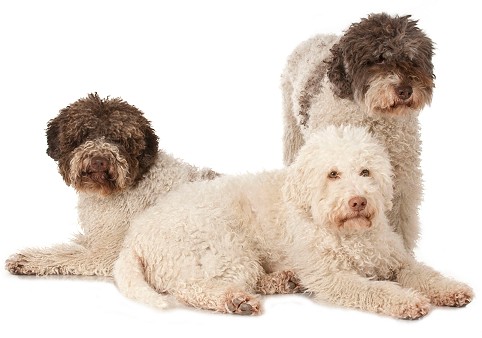
Lagotto Romagnolo (la-GOT-toe ro-man-YO-lo)
To relieve (and prevent) constipation:
- Keep any longish hair around the anus clean, and clipped short.
- Have your vet check the anal glands for fullness or impaction. Check also for disk disease and hip dysplasia, which can make it painful to crouch and arch the back.
- Throw out kibble and feed real food – its built-in moisture bathes and flushes the intestines.
- Add more water to your dog's homemade meals.
- Increase fiber with raw veggies pulverized in a food processor for easy digestibility.
- Add canned pumpkin (NOT pumpkin pie filling), which adds both moisture and fiber.
- Increase exercise, which makes the bowels move more readily.
- If you want to feed bones, go slowly when introducing them to your dog. If constipation keeps happening, don't feed bones!
- Keep your dog away from small toys in your kids' rooms.
- Give your dog more opportunities for potty breaks throughout the day.
If the dog is truly constipated, pick up some psyllium husk powder from the health food store, and add this fibrous supplement to one of your dog's daily meals – 1/4 tsp for a dog up to 15 pounds; 1/2 tsp for 15-25 pounds; 3/4 tsp for 25-50 pounds; 1 teaspoon for larger dogs.
Blood (and other stuff) in the stool
Abnormal: Blood, which may be bright red or tarry black. If it's simply a tinge of blood, I wait to see if it's repeated. If it's considerably more than a tinge, I call the vet. In an adult dog, copious bloody diarrhea that looks like raspberry jam and comes on suddenly could suggest hemorrhagic gastroenteritis.
Abnormal: What look like "grains of rice" in the stool (assuming you're not feeding rice!) may be tapeworm segments. Gross.
Abnormal: Bits of leaves, sticks, gravel, etc., in the stool. Since these could lead to an impaction, you'll need to be more vigilant about removing those tempting bits of nature from your dog's yard. Or else confine him in a safer part of the yard.
Abnormal (but not serious): Bits of vegetables in the stool. If you're feeding vegetables and they're coming out in recognizable form, they're not being digested properly. Grind them up more finely in the food processor for easier digestibility. If they still come out in the stool, cut back on volume. Not all dogs can digest veggies.
Gas (flatulence)
Finally, a problem seldom mentioned in polite company!
- Dogs can be gassy when they eat kibble or canned food that contains hard-to-digest ingredients such as grains, legumes (peas, lentils, etc.), and starchy vegetables like potatoes. The solution is to feed only real meat, fish, eggs, and a few less-gassy steamed veggies such as zucchini and green beans.
- Short-faced breeds can be gassy because their deformed respiratory system forces them to snort and snuffle and swallow air... which must then escape from the body... somehow!
- Dogs can be gassy when they eat too fast, which makes them swallow air. To slow down a gulper, feed four small meals per day. Or feed him in a private area with no other dogs lurking around as competition. Or place a good-sized rock or a chain with big links in his food dish so that he must pick slowly around the obstacle.
Take your dog's temperature
Different dogs have slightly different "normal" temperatures, so it's a good idea to take your dog's temperature when he's healthy so you'll have something to compare it to if you ever need to take it when he's sick.
- You need a RECTAL thermometer.
- "Shake it down" to about 95 degrees.
- Grease the bulb end with KY jelly, vaseline, or vegetable oil.
- Have your dog "Stand." You may need someone to hold him still.
- Lift his tail and insert the bulb end slowly, with a twisting motion. If you meet resistance, you're probably hitting stool, so don't push any further.
- Hold it there for 2 minutes or until it beeps (depends on your particular thermometer).
- Remove it, wipe it clean with a tissue, and read the temperature.
For most dogs, normal temp is 100 to 102.5 degrees (pups and small dogs tend to be on the higher end of that range). If it's below 99 or above 104, repeat, leaving the thermometer in a bit longer. If it's still low or high, do you have a second thermometer you can try? When multiple readings on multiple thermometers are low or high, call the vet.
And now, thank heavens, we're done with your dog's "nether regions"!
Energy level
We've been looking at your dog's individual body parts, but a dog isn't simply a collection of physical body parts. An essential part of his health is his energy, his vigor, his spirit.
How does your dog FEEL?
- Is there a light shining in his eyes?
- Is there a spring in his step?
- Is he interested in the world around him?
- Is he eating?
- Is he playing?
Sometimes the very first symptom of a serious illness is nothing more than listlessness, lethargy, dullness, or loss of enthusiasm.
Bloat (Gastric Torsion): The 6-Hour Killer
I've decided to end this article with a group of symptoms that all dog owners should know by heart.
These symptoms belong to an emergency gastrointestinal syndrome that strikes suddenly (in a matter of hours) and is often fatal. Bloat or gastric torsion is the second or third leading cause of death in many large and giant breeds.
Even if you don't own a large breed, chances are that you know someone who does. If you happened to be visiting that person, your recognition of these symptoms could save their dog's life. That's a good reason to at least look at this list, right?
If a large dog:
- has a swollen (bloated) stomach that feels hard
- is clearly uncomfortable, perhaps pacing restlessly
- drools or retches or tries to throw up – but cannot
- tries to go to the bathroom – but cannot
- pants rapidly or assumes a "prayer position" with his front paws and chest on the ground, hindquarters in the air, as he tries to relieve the pressure in his stomach
RUSH him to the vet. There's not a moment to lose.
My best-selling books – now available FREE on my website
 Respect Training For Puppies: 30 seconds to a calm, polite, well-behaved puppy is for puppies 2 to 18 months old. Your puppy will learn the 21 skills that all family dogs need to know. Click here to read for free.
Respect Training For Puppies: 30 seconds to a calm, polite, well-behaved puppy is for puppies 2 to 18 months old. Your puppy will learn the 21 skills that all family dogs need to know. Click here to read for free. Teach Your Dog 100 English Words is a unique Vocabulary and Respect Training Program that will teach your adult dog to listen to you and do what you say. Click here to read for free.
Teach Your Dog 100 English Words is a unique Vocabulary and Respect Training Program that will teach your adult dog to listen to you and do what you say. Click here to read for free. 11 Things You Must Do Right To Keep Your Dog Healthy and Happy helps your dog live a longer, healthier life. Get my honest advice about all 11 Things before you bring home your new puppy, because some mistakes with early health care cannot be undone. Click here to read for free.
11 Things You Must Do Right To Keep Your Dog Healthy and Happy helps your dog live a longer, healthier life. Get my honest advice about all 11 Things before you bring home your new puppy, because some mistakes with early health care cannot be undone. Click here to read for free.
